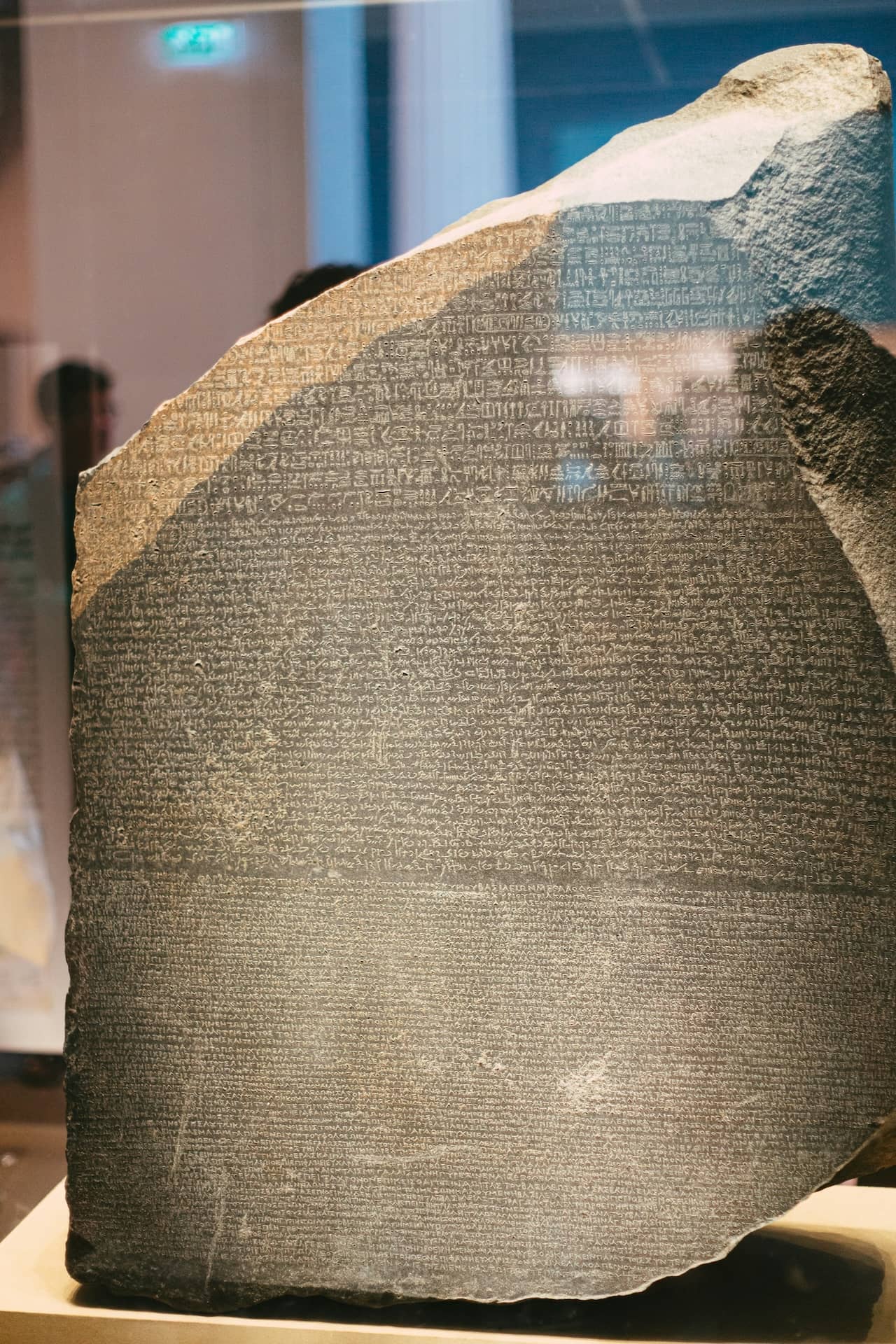The Rosetta Stone: the Key to Solving a Linguistic Puzzle
When it comes to archaeological discoveries, few can match the enduring significance and intrigue of the Rosetta Stone. This artefact came to light when Napoleon’s soldiers stumbled upon it more than 200 years ago. From its discovery, it soon became evident that it was no ordinary stone block. So why was this unearthing so remarkable? Read Transly‘s blog post to get a glimpse.
According to some accounts, the Stone was accidentally found in the city of Rosetta (hence its name), where French soldiers were fortifying a crumbling wall. The stele made from granodiorite was built into this very same wall. The Stone contains an inscription with a decree issued by a council of priests at Memphis in 196 B.C. on behalf of King Ptolemy V. The decree appears in three scripts:
- The upper text contains Ancient Egyptian hieroglyphs, often used in priestly decrees.
- The middle portion is written using the Demotic script, which was used on a daily basis.
- The lowest is written in Ancient Greek, a script used for administrative purposes.
The decree (known as the Rosetta Stone decree or the Decree of Memphis) confirmed the royal cult of Ptolemy V and mentions the Egyptian rebellion against the Greek rulers, which was otherwise known only through Greek sources and the remains of graffiti. The native Egyptian population at home was treated as second-class citizens by the Greek rulers and imperialists, while the economy suffered because of the wars. The decree was a confirmation of the king’s legitimacy and his commitment to the Egyptian people.
Two Languages and Three Scripts to Unlock the Past
While there are other artefacts (such as the Philae Obelisk or the Code of Hammurabi) that contain valuable historical and linguistic information about ancient Egypt and other civilizations, the bilingual and tri-scriptural nature of the Rosetta Stone is what made it so helpful in decoding the Egyptian hieroglyphs.
Before the discovery of the Rosetta Stone, hieroglyphics were considered an unsolvable puzzle due to their falling into disuse centuries earlier. The last known hieroglyphic inscription dated back to around 400 A.D., while Demotic, a script derived from hieroglyphs, had its last known inscription a few decades later, in 452 A.D. As a result, the ability to read and write hieroglyphic texts was lost in time.
The turning point arrived in the 19th century. Scholars of this era knew ancient Greek and could, therefore, piece together the hieroglyphic translation based on the Greek message. One such scholar was the English physician and physicist Thomas Young, who was fascinated with ancient Egyptian culture. His rival, French philologist Jean-Francois Champollion, was also on a quest to decipher the texts. Both significantly contributed to cracking the code during the so-called Rosetta Stone decipherment race.
Thomas Young’s breakthrough came when he used the Rosetta Stone cartouches to identify the rulers’ names and then work out the sounds of some of the hieroglyphs. Then Champollion, using his knowledge of the Coptic language, further expanded these observations, finally fully deciphering the hieroglyphic script and creating the alphabet of phonetic hieroglyphs, which other scholars could use to translate the inscription in its entirety.
A Subject of Controversy
The Rosetta Stone is currently housed in the British Museum and, to this day, is one of its most important artefacts. Despite being well known, the Stone has been controversial for many years.
The Stone was discovered in Egypt by the French in 1799 and was taken to England in 1802 as part of a peace treaty between France and Britain. Some critics argue that displaying the Rosetta Stone and other artefacts from colonial contexts in Western museums can perpetuate cultural appropriation and Eurocentric narratives of history. In recent years, there has been an increasing demand from the Egyptian government and the public for the return of the Rosetta Stone. The Stone is seen as a symbol of Egypt’s cultural heritage, and many believe it was taken illegally from the country. However, the British Museum has refused to return the Stone, arguing that it was acquired legally and is an integral part of world heritage.
The controversy surrounding the Rosetta Stone is not limited to its ownership. The Stone’s translation has also been a subject of debate. The decipherment of the hieroglyphs on the Stone was a significant achievement in the history of linguistics. However, there is still some disagreement over who should be credited with the triumph of solving the hieroglyphic code.
Despite the controversy, the Rosetta Stone remains an essential artefact in the study of ancient Egyptian history and language. While well-known, it is far from being the only object that has helped decipher hieroglyphs. This further highlights the importance of preserving cultural and linguistic heritage so it can withstand the test of time.
Further Reading
The British Museum (14.07.2017): Everything you ever wanted to know about the Rosetta Stone
Smithsonian Magazine (27.09.2022): Two Hundred Years Ago, the Rosetta Stone Unlocked the Secrets of Ancient Egypt
The Public Broadcasting Service (30.11.2022): Egyptians call on British Museum to return the Rosetta Stone
The Conversation (06.03.2023): I dug for evidence of the Rosetta Stone’s ancient Egyptian rebellion – here’s what I found
